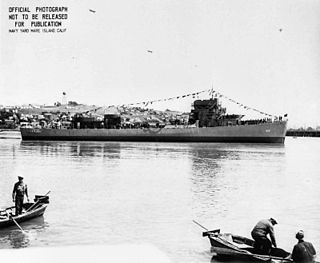
The fourth USS Dale (DD-353) was a Farragut-class destroyer in the United States Navy during World War II. Dale received 14 battle stars for World War II service. She was named for American Revolutionary war hero Richard Dale.

USS John C. Butler (DE-339) was the lead ship of her class of destroyer escorts in the service with the United States Navy from 1944 to 1946. She was recommissioned between 1950 and 1957 and finally sunk as a target in 1971.

USS Helm (DD-388) was a Bagley-class destroyer in the United States Navy during World War II. She was named for Rear Admiral James Meredith Helm. Helm received 11 battle stars for her World War II service in the Pacific.

The third USS Macdonough (DD-351) was a Farragut-class destroyer in the United States Navy during World War II. She was named for Thomas Macdonough.

The second USS Gridley (DD-380) was the lead ship of her class of destroyers in the United States Navy. She was the second US Navy ship named for Charles Vernon Gridley. She served with distinction in the Pacific Theater during the Second World War and shared in the sinking of a Japanese submarine.

USS Porterfield (DD-682) was a Fletcher-class destroyer of the United States Navy. She was laid down by the Bethlehem Shipbuilding, San Pedro, California 12 December 1942; launched 13 June 1943; sponsored by Mrs Louis B. Porterfield and commissioned 30 October 1943, with Commander J. C. Woefel in command.

USS Bebas (DE-10) was an Evarts-class destroyer escort in the service of the United States Navy from 1943 to 1945.

USS McClelland (DE-750) was a Cannon-class destroyer escort built for the United States Navy during World War II. She served in the Pacific Ocean and provided escort service against submarine and air attack for Navy vessels and convoys. Post-war she was reassigned as a training vessel.

USS Halloran (DE-305) was a Evarts-class destroyer escort of the United States Navy.

USS LeHardy (DE-20) was an Evarts-class destroyer escort constructed for the United States Navy during World War II. It was promptly sent off into the Pacific Ocean to protect convoys and other ships from Japanese submarines and fighter aircraft. At the end of the war, she had to honor of proceeding to Wake Island, as the Japanese commander surrendered, and raising a flagpole to fly the American flag once again.
The second USS Dempsey (DE-26) was an Evarts-class destroyer escort constructed for the United States Navy during World War II. She was promptly sent off into the Pacific Ocean to protect convoys and other ships from Japanese submarines and fighter aircraft. By the end of the ship's World War II service career, when she returned to the United States, she had accumulated three battle stars.

USS Emery (DE-28) was an Evarts-class destroyer escort constructed for the United States Navy during World War II. It was promptly sent off into the Pacific Ocean to protect convoys and other ships from Japanese submarines and fighter aircraft. By the end of the war, she had accumulated three battle stars.

USS Lovering (DE-39) was an Evarts-class destroyer escort of the United States Navy during World War II. She was promptly sent off into the Pacific Ocean to protect convoys and other ships from Japanese submarines and fighter aircraft. She performed dangerous work in major battle areas and sailed home with three battle stars.

USS Mitchell (DE-43) was an Evarts-class destroyer escort constructed for the United States Navy during World War II. She was sent off into the Pacific Ocean to protect convoys and other ships from Japanese submarines and fighter aircraft. She performed escort and anti-submarine operations in dangerous battle areas and was awarded nine battle stars, a very high number for a ship of her type.

USS Cloues (DE-265) was an Evarts-class destroyer escort of the United States Navy during World War II. She was sent off into the Pacific Ocean to protect convoys and other ships from Japanese submarines and fighter aircraft. She performed escort and antisubmarine operations in dangerous battle areas and returned home with three battle stars.

USS Finnegan (DE-307) was an Evarts-class destroyer escort constructed for the United States Navy during World War II. She was sent off into the Pacific Ocean to protect convoys and other ships from Japanese submarines and fighter aircraft. She performed escort and antisubmarine operations in dangerous battle areas and returned home with three well-earned battle stars.

USS Kyne (DE-744) was a Cannon-class destroyer escort built for the United States Navy during World War II. She served in the Pacific Ocean and provided escort service against submarine and air attack for Navy vessels and convoys. She returned home after the war with a very commendable accumulation of six battle stars.

USS Richard S. Bull (DE-402) was a John C. Butler-class destroyer escort in service with the United States Navy from 1944 to 1946. She was finally sunk as a target in 1969.

USS McCoy Reynolds (DE-440) was a John C. Butler-class destroyer escort acquired by the U.S. Navy during World War II. The primary purpose of the destroyer escort was to escort and protect ships in convoy, in addition to other tasks as assigned, such as patrol or radar picket. Post-war, after operating in the Pacific Ocean battle areas, her crew members returned home with four battle stars to their credit for World War II and one for the Korean War.

USS Loeser was a Buckley-class destroyer escort of the United States Navy, named in honor of Lieutenant Commander Arthur E. Loeser (1903–1942).



















